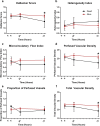Microcirculatory perfusion disturbances in septic shock: results from the ProCESS trial
- PMID: 30458880
- PMCID: PMC6245723
- DOI: 10.1186/s13054-018-2240-5
Microcirculatory perfusion disturbances in septic shock: results from the ProCESS trial
Abstract
Background: We sought to determine the effects of alternative resuscitation strategies on microcirculatory perfusion and examine any association between microcirculatory perfusion and mortality in sepsis.
Methods: This was a prospective, formally designed substudy of participants in the Protocolized Care in Early Septic Shock (ProCESS) trial. We recruited from six sites with the equipment and training to perform these study procedures. All subjects were adults with septic shock, and each was assigned to alternative resuscitation strategies. The two main analyses assessed (1) the impact of resuscitation strategies on microcirculatory perfusion parameters and (2) the association of microcirculatory perfusion with 60-day in-hospital mortality. We measured sublingual microcirculatory perfusion using sidestream dark field in vivo video microscopy at the completion of the 6-h ProCESS resuscitation protocol and then again at 24 and 72 h.
Results: We enrolled 207 subjects (demographics were similar to the overall ProCESS cohort) and observed 40 (19.3%) deaths. There were no differences in average perfusion characteristics between treatment arms. Analyzing the relationship between microcirculatory perfusion and mortality, we found an association between vascular density parameters and mortality. Total vascular density (beta = 0.006, p < 0.003), perfused vascular density (beta = 0.005, p < 0.04), and De Backer score (beta = 0.009, p < 0.01) were higher overall in survivors in a generalized estimating equation model, and this association was significant at the 72-h time point (p < 0.05 for each parameter).
Conclusions: Microcirculatory perfusion did not differ between three early septic shock treatment arms. We found an association between microcirculatory perfusion parameters of vascular density at 72 h and mortality.
Trial registration: ClinicalTrials.gov, NCT00510835 . Registered on August 2, 2007.
Keywords: Microcirculation; Mortality; Pathophysiology; Sepsis.
Conflict of interest statement
Authors’ information
No additional information provided.
Ethics approval and consent to participate
The Beth Israel Deaconess Medical Center Committee for Clinical Investigations and each site’s review board approved the study design. Each subject or legal representative gave written informed consent.
Consent for publication
Not applicable.
Competing interests
No nonfinancial conflicts of interest exist for any of the authors. NIS and MJM have previously received equipment support from MicroVision Medical BV.
Publisher’s Note
Springer Nature remains neutral with regard to jurisdictional claims in published maps and institutional affiliations.
Figures


